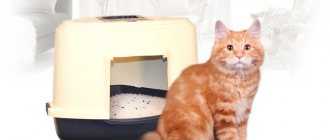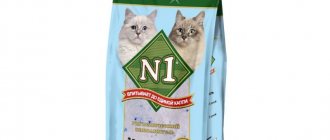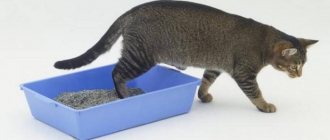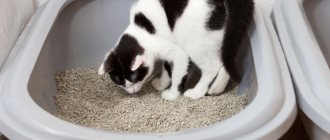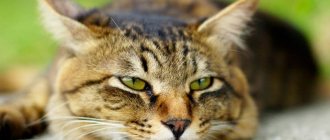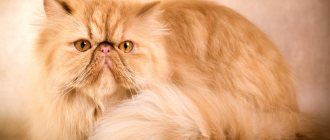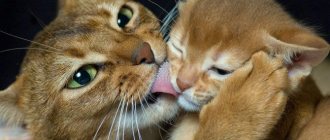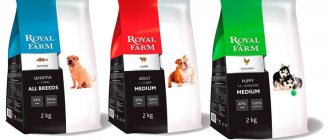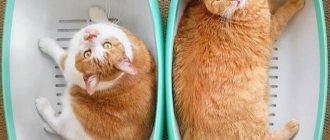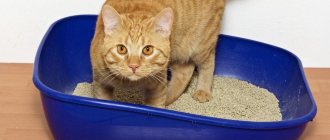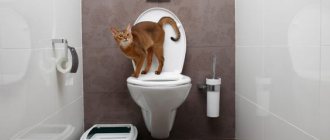Street, tray or toilet?
This is the main question, the answer to which will largely determine further actions. Undoubtedly, using a shared toilet with your pet has many advantages. Firstly, savings. There is no need to buy cat litter (silica gel, sand, sawdust, etc.), the litter box itself, or accessories for cleaning it. Secondly, convenience. There is no additional source of infection in the house. However, not every cat will agree to use a regular toilet. And not every housewife wants to keep it with the lid open all the time (otherwise there is no other way). In addition, due to carelessness, an animal may fall into the water or slam the lid on its head, after which it will become wary of the source of its troubles and may begin to misbehave. Not everyone will be able to walk a cat outside either. Most owners are against their pet trampling its clean paws on the asphalt, the ground, or roaming around in basements. That's why many people choose a tray.
What does the filler look like?
The chemical composition of the silica gel filler for cats is defined as a hydrophilic sorbent, and is formed by the process of drying a special gel.
Almost 99% of the filler consists of this substance. In its normal state, when purchased in a store, it consists of small balls, completed and pressed into packaging.
Multi-colored balls are made for the purpose of beauty and aesthetics for both owners and cats. Also, many creators add flavoring to the fillers for these purposes.
If we talk about the texture of the granules themselves, then it can also vary in shape, among which there are: round, with sharp edges, and crystal-shaped balls. The same phenomenon is observed in sizes. Here you need to know one secret. The greater the weight, as well as the length and thickness of the cat's fur, the larger the granules should be.
Filler selection options
- the presence of granules in the packaging without dust and impurities;
- taking into account the weight and nature of the animal’s fur;
- abandon the frequent use of colored fillers in favor of natural white;
- Don’t be tied to price, focus on quality.
What types of fillers are there?
Many animals use empty trays. This is economical, but unhygienic. After all, the cat steps with its paws in its own feces, after which it spreads it all over the floor, furniture and other objects. So it’s better to spend some money on filling the tray than to put the health of your family members at risk. Moreover, in any specialized store they are offered in the widest assortment. Globally, fillers can be divided into clumping and crumbling. The former, under the influence of moisture, form a tight connection (like stone), the latter, on the contrary, fall apart, turning into dust. The clumping ones include mainly clay and silica gel fillers, and the crumbling ones include pressed sawdust. There are also combined options containing various granules. They are usually used as a transitional option to accustom the animal to new material. In addition to composition, fillers also differ in granule sizes (there are small, medium and large). They are chosen depending on the age, size and preferences of the animal.
Which to choose
There are many manufacturers producing high-quality silica gel, but there are proven, reliable brands that are in great demand.
- The leading position in the ranking of silica gel fillers is occupied by a product called "AnimAll". This line of Chinese-made products has an advantageous price-quality ratio, and also attracts with a huge range of types, colors, and aromatic additives.
- The Chinese composition, located in the same price segment, has proven itself well; it is distinguished by the presence of hypoallergenic varieties.
- Means "Kotix" also widely represented on the market. It has a higher price compared to previous representatives, but it is compensated by good quality. The filler granules are small and have a high ability to retain unpleasant odors - accordingly, the product is consumed more economically.
- “Trixie” is a series of more expensive mixtures, produced in Germany, the granules practically do not create dust, which is ideal if there are allergy sufferers in the house. Unlike representatives of previous brands, this filler “binds” the smell immediately after urine hits it.
Did you know? Craftsmen have found an unusual use for cat hygiene products. If you get your phone wet, remove the battery and place the device in a container with silica gel overnight.
What is silica gel?
If we answer the question from a chemical point of view, then this is a fairly simple compound, or rather, a dried gel of silicate acid. It is obtained by colloidally mixing silicon dioxide with water. But it is not the chemical, but the physical properties of this substance that are of interest. More precisely, the ability to absorb moisture.
Silica gel has a porous (hydrophilic) surface. Due to this quality, it is often used for drying air or other gases. In boxes with shoes, clothes, and equipment, you often find paper bags with transparent crystals inside. This is silica gel. The material has been widely used, from household to industrial.
In addition to water, silica gel adsorbs many other compounds. Therefore, it is often used to trap harmful substances. Relatively recently, they began to use silica gel for cat litter, and quite successfully. It is also an excellent catalyst for chemical reactions.
Which filler is better?
As mentioned above, the main options for hygienic fillings for trays are clay, sawdust and silica gel. Choosing cat litter can be very difficult. Each material has both advantages and disadvantages. In addition, the final decision is still made by the animal, and he is little concerned about sanitary conditions and price characteristics.
If we consider clay filler, it is good for its low price, but it does not handle odors very well. As a rule, a lot of grains accumulate around the tray, and in the process of “digging” the animal creates a whole cloud of dust, which is not very convenient. In addition, cats sometimes swallow pieces of litter, which is hardly beneficial.
Another, more popular option made from compressed sawdust is very popular with the animals themselves. Affordable price and ease of disposal (after use it is flushed down the toilet) made it popular. In addition, sawdust is often additionally flavored, which is what cat owners like so much. But, unfortunately, they do not absorb liquid very well, so the contents of the tray have to be changed quite often. And there is a lot of garbage from them; animals take small particles all over the apartment. They often cause allergies.
Silica gel cat litter is more expensive than both clay and wood. But in the end it turns out to be more economical, since, thanks to its high absorbent qualities, it is changed much less often.
Advantages and disadvantages
Granules with a porous structure are so effective that they absorb not only cat urine that gets on them, but also moisture from the air. But, like any product, this type of filler has strengths and weaknesses, which are described in the table below:
| Advantages | Flaws |
| Due to the high porosity of silicate beads, the filler has high absorbent properties and can significantly reduce the level of humidity in the area where the tray is located. | If your kitten accidentally eats particles of silica gel litter, he may experience stomach problems. |
| These are chemically inactive materials that are not exposed to high temperatures. | Can't be flushed down the toilet. |
| The occurrence of mold and pathogenic bacteria is excluded. | Hard, sharp crystals provoke injuries to the animal's paws. |
| Effectively combat and neutralize unpleasant odors. | When liquid gets on the silica gel filler, it begins to hiss. This sound can frighten the cat and she may not want to go to such a litter box anymore. |
| The filler does not stick to the pet's paws and fur. | |
| The granules absorb a sufficient amount of liquid, so there is no need to change the contents of the tray daily. |
It is worth noting that this type of cat litter is expensive. But, at the same time, it is characterized by incredible efficiency and low consumption.
Advantages of silica gel filler
Firstly, this material itself is very light. This advantage will certainly be appreciated by cat owners who know what it costs them to drag a 7-10 kilogram bag of clay or sawdust up to the 5th floor without an elevator.
Secondly, silica gel cat litter is partially changed every 2-3 days, and completely changed after 2-3 weeks. It turns out both economical and convenient. For those who are obsessed with cleanliness, it is also recommended to choose a silica gel litter. Reviews of this material, regardless of the manufacturer, say that traces of its presence in the room are practically invisible (which cannot be said about sand, clay or sawdust).
In addition, the granules perfectly absorb not only moisture, but also odors. So you will never be able to detect a cat litter box by its characteristic “aroma” if this particular material is used in it.
How to use silica gel filler
Using this type of filler does not cause any trouble. The first step is to prepare the tray - wash and dry it. Then the silica gel mixture is poured into it in a layer of about five centimeters. Different manufacturers claim different numbers, which can be found on the packaging.
Several times a day, the entire volume of filler must be thoroughly mixed. This is done so that the crystals, which can no longer absorb liquid, are evenly distributed throughout the tray. If left in one place, they will not be able to absorb and retain moisture, which can cause damp areas to form in the litter box.
If solid waste appears in the total volume of the filler, you should use a special scoop to remove it without picking up the granules.
A complete update of the filler is carried out approximately once every three to four weeks. These terms may differ for different manufacturers. On average, a four-liter package lasts about a month. It is worth remembering that if the cat is large or there are several pets, then replacement must be performed more often.
This type of filler can only be disposed of with household waste, since flushing it down the toilet creates a large clog. Tie the bag tightly so that the used litter does not spill out and become food for street animals or birds.
About the disadvantages
As we know, ideal things in this world do not exist. So even silica gel cat litter, despite all its advantages, has a number of disadvantages. Firstly, the cost. A small bag of translucent granules will cost several times more than a large (and heavy) bag of sawdust. True, taking into account the economical consumption, it turns out not so expensive, but still, it is the price that scares many.
Secondly, some animals are afraid of him. Or rather, the sounds that silica gel can make. Cat litter made of this material rustles loudly when a cat digs in it (most animals simply cannot live without it). But the worst thing is the hissing. When liquid is absorbed, the process occurs so rapidly that it is accompanied by quite loud, frightening sounds. Undoubtedly, over time the cat will get used to the hissing and rustling, but at first it may experience some discomfort and even stress.
The third thing that stops cat owners from buying silica gel is its composition. If everything is clear with sawdust, sand or clay, then many do not know what this material is made of and consider it a complex (and harmful) chemical compound. This is undoubtedly a misconception, and the crystals themselves are no more toxic than ordinary sand. However, they can be dangerous if swallowed (there is a risk of dehydration). And the specific smell of silica gel, imperceptible to humans, sometimes simply scares away animals.
Flaws
However, the use of silica gel filler also has disadvantages, although there are very few of them:
- the high cost of silica gel (this is true, the packaging is not cheap, however, if you follow the instructions, this product will be used more economically than its other analogues);
- It is not allowed to use small kittens for toileting, since eating mixture pellets, which is typical for babies, can lead to poisoning;
- In the production of silica gel, substances are used that can be toxic if they enter the cat’s digestive tract, so this option is not suitable for cats that are prone to testing everything.
When caring for cats, learn how to teach a pet to brush its teeth, why a cat needs a haircut, how to sew and put on a blanket, how to bathe a kitten and how to deliver a cat.
Is it possible to accustom a cat to a new litter?
Sometimes this becomes necessary. For example, if an animal comes into the house having been accustomed to clay or sawdust, and its owner considers this not very hygienic and prefers to use silica gel. Veterinarians and professional breeders recommend making any changes gradually. This applies to food, toilet, and other issues. That is, if the cat is accustomed to pressed sawdust, but the owner does not like it, the ideal option is to continue to sprinkle it, adding silica gel little by little. As soon as the animal stops concentrating its attention on the crystals, their number is increased. Thus, you can gradually switch completely to silica gel cat litter. At the same time, the owner will be happy, and the animal will not experience much stress.
Which tray is best to use?
There are also a great variety of them: closed and open, deep and not very deep, with and without bars. There are even stylized ones to resemble all kinds of interior items. However, when choosing a tray, do not forget about its intended purpose. In addition to aesthetic qualities, it must also contain practical ones. First of all, this is the animal’s ease of access, its convenience, as well as the ability to easily wash the container or change the filler.
The shape and depth of the tray are purely individual and depend on the size of the animal, as well as its behavior. For example, if a cat likes to rummage heartily through the litter, you should not choose a container that is too small, otherwise the crystals will be scattered throughout the room. For such cases, there are trays with high sides or even a roof. Animals sitting on the very edge or even the edge of the vessel should be offered a flatter shape so that the cat does not turn it over under its own weight. In general, you can start with a universal “basin” of medium depth, and then experiment and observe.
In fact, the toilet for an animal, as for a person, is a rather intimate and strictly individual matter. Therefore, it is better to choose the number of trays, their shape, and fillers so that both the cat and its owner are comfortable. In this case, the apartment will always be clean and there will be no unpleasant surprises.
Which tray to choose
There are many varieties of cat litter boxes and, as a rule, the type of litter is not a selection criterion in this case. Nevertheless, you need to take into account the wishes of the owner and the peculiarities of the animal’s habits when choosing a toilet for your pet.
- If you plan to use litter, then you should immediately discard trays with mesh - they are intended for cats that are not accustomed to having contents in a potty or there is a need to ensure the cleanliness of the latrine (for example, for animals that have undergone surgery).
- Automated trays with a self-cleaning function are a new trend for cat owners, but such an innovation will easily scare the pet if it is nearby at the time of “cleaning”.
- The owners really like closed trays with a roof because they do not allow the filler to spill onto the floor. This toilet is suitable for timid animals who try to hide while recovering from natural needs.
- For most cats, the best potty option is a regular plastic tray without a mesh. If the owner wishes, you can purchase such a tray with an additional side, the installation of which will prevent the contents from scattering.
Find out the basic criteria for choosing a cat tray and cat litter.
